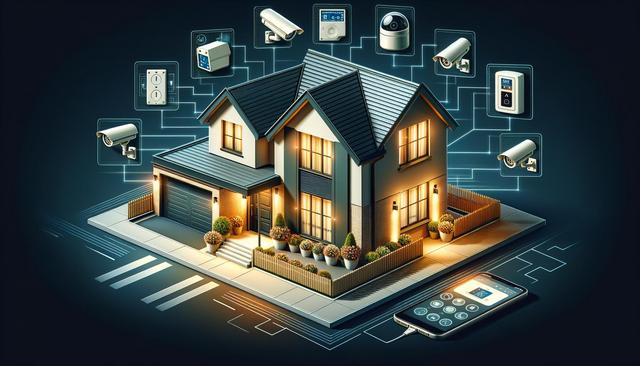
A Comprehensive Look at Home Security Systems
Understanding the Basics of Home Security Systems
Home security systems are designed to protect your residence from unauthorized entry, theft, and other potential threats. These systems often include a combination of sensors, alarms, cameras, and monitoring services. At their core, they work by detecting unusual activity and alerting either the homeowner or a monitoring service provider. The system can be as simple as a door sensor and alarm or as complex as a fully integrated smart system that includes surveillance, motion detection, and mobile alerts.
There are two primary types of home security systems: wired and wireless. Wired systems are typically more stable and don’t rely on Wi-Fi, while wireless systems offer greater flexibility and ease of installation. Choosing between the two often depends on the structure of your home and your specific security needs. Many systems now also offer smart home integration, allowing users to control them via smartphone apps or virtual assistants.
Features to consider when evaluating a home security system include:
- 24/7 monitoring
- Remote access and control
- Multiple sensor types (motion, glass break, window/door)
- High-definition security cameras
- Battery backup for power outages
Understanding these basics can help you make a more informed decision when choosing a system tailored to your specific needs.
Benefits of Installing a Home Security System
There are numerous advantages to installing a home security system, especially when it comes to enhancing your home’s safety and your personal peace of mind. One of the most significant benefits is deterrence. The presence of a visible security system can discourage potential intruders from targeting your home in the first place. Even yard signs or window stickers indicating that a home is protected can be enough to make a would-be thief think twice.
Another key benefit is the ability to respond quickly to emergencies. With professional monitoring services, authorities can be dispatched almost immediately when an alarm is triggered. This rapid response can reduce the risk of property damage or personal harm. Additionally, modern systems often include carbon monoxide and fire detection, offering a more comprehensive safety net beyond just burglary prevention.
Some additional benefits include:
- Remote monitoring through mobile apps
- Insurance premium discounts
- Integration with other smart devices (lights, thermostats)
- Increased resale value of your home
For homeowners seeking a sense of security and convenience, these systems provide a reliable line of defense against a wide range of threats.
Choosing the Right System for Your Home
Selecting the right home security system involves assessing your property, lifestyle, and budget. Start by evaluating the size of your home and the number of entry points that need protection. Apartments may only require a few sensors and a basic alarm, while larger homes with multiple access points might need a more comprehensive setup with cameras and additional monitoring.
It’s also important to consider how tech-savvy you are and whether you want a DIY or professionally installed system. DIY systems are generally more affordable and offer easy installation, while professionally installed systems may come with contracts and higher upfront costs but often include expert setup and support.
When comparing options, look at:
- Monthly monitoring fees
- Equipment costs
- Contract terms
- Customer support and service history
Reading reviews and comparing features across different providers can help you find a system that aligns with your specific security goals. Be sure to also check for compatibility with existing smart home devices if integration is a priority for you.
Integrating Smart Technology with Home Security
Smart home technology has revolutionized how we interact with home security systems. Today’s systems often come with mobile apps that allow homeowners to monitor and control their setup from anywhere in the world. This integration provides real-time updates, video feeds, and system status notifications directly to your phone or tablet.
Smart locks, video doorbells, and voice-controlled assistants are now commonly integrated with home security systems. These devices not only enhance security but also add convenience. For instance, you can unlock your front door remotely for a visitor or check who’s at the door using a smart video system, even when you’re not home.
Key benefits of smart integrations include:
- Remote arming and disarming
- Custom alerts and automation
- Energy efficiency through automation
- Seamless control via smart hubs
As smart home ecosystems continue to evolve, the ability to customize and expand your home security system will become even more accessible and user-friendly.
Maintenance and Long-Term Considerations
Installing a home security system is just the beginning – ongoing maintenance is essential to ensure it works effectively when needed. Regularly testing your system, replacing batteries, and updating software are important practices to keep everything running smoothly. Many systems are now designed to alert users when maintenance is required, making upkeep simpler than ever.
Homeowners should also account for future needs. For instance, if you plan to renovate or move, consider how easily the system can be expanded or relocated. Wireless systems generally offer more flexibility in this regard compared to wired installations. Additionally, keeping up with new updates and features can enhance the long-term value of your investment.
Tips for long-term maintenance:
- Conduct monthly system tests
- Review and update emergency contact lists
- Clean camera lenses and sensors periodically
- Check for firmware and software updates
Taking a proactive approach to maintenance ensures your home security system remains reliable and continues to provide protection for years to come.
Conclusion: Protecting What Matters Most
Home security systems play a vital role in safeguarding your property and loved ones. Whether you live in a small apartment or a large home, there’s a configuration that fits your needs and lifestyle. By understanding the components, benefits, and maintenance requirements, you can make an informed decision that brings long-term value and peace of mind. As technology continues to advance, these systems are becoming more accessible, customizable, and effective than ever before. Investing in a well-suited home security system is not just about preventing crime—it’s about creating a safer, more connected living environment.


